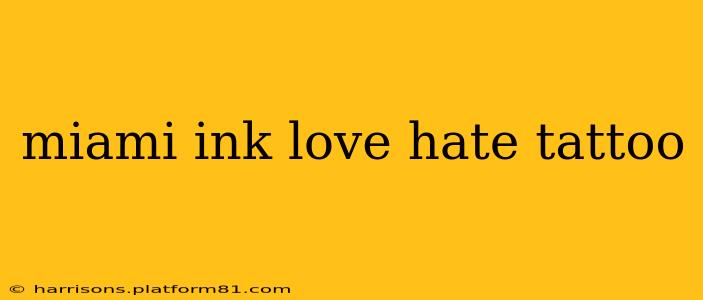Miami Ink, the reality TV show that captivated audiences with its raw portrayal of the tattooing world, left an indelible mark on popular culture. Beyond the drama and personalities, the show highlighted the powerful symbolism embedded in tattoos, often reflecting the complex emotions of love and hate. This exploration delves into the intricate relationship between these opposing forces and their representation in the art of tattooing, particularly as depicted in Miami Ink.
What made Miami Ink so popular?
Miami Ink's popularity stemmed from a potent combination of factors. The show offered a glimpse into a subculture often misunderstood, showcasing the skill and artistry involved in tattooing. The personalities of the artists, their individual styles, and their interactions with clients created compelling narratives. Furthermore, the show tapped into the emotional resonance of tattoos – their ability to convey deep-seated feelings, memories, and life experiences. The raw and sometimes confrontational interactions between artists and clients added a layer of realism rarely seen on other reality shows. The mix of high-stakes artistry, personal stories, and compelling interpersonal dynamics formed a recipe for success that captivated a broad audience.
What are some common love and hate tattoo designs?
Love and hate, being fundamental human emotions, lend themselves to diverse and often contrasting tattoo designs. Love is frequently depicted through:
- Hearts: Classic and enduring symbols of affection, hearts can be intricately designed or kept simple, reflecting the nature of the love being portrayed.
- Names and Portraits: A deeply personal tribute, names and portraits of loved ones serve as constant reminders of affection and commitment.
- Infinity Symbols: These signify everlasting love and enduring bonds.
- Flowers and Floral Arrangements: Flowers, particularly roses, lilies, and lotuses, often symbolize love, beauty, and passion.
Conversely, hate is more subtly expressed, often through:
- Abstract Designs: Sharp lines, dark colors, and chaotic patterns can visually represent the intensity and turmoil of hatred.
- Symbolic Imagery: Skulls, thorns, or barbed wire can suggest pain, betrayal, and resentment.
- Tribal Designs: Some tribal patterns, with their aggressive or protective symbolism, can be interpreted as expressions of anger or defiance.
- Geometric Patterns: While often aesthetically pleasing, angular and sharply defined geometric shapes might subtly convey feelings of rigidity, coldness, or a sense of separation.
How did Miami Ink portray the love/hate dichotomy in tattoos?
Miami Ink showcased the emotional complexity embedded in tattoos through client stories. Many clients sought tattoos to commemorate significant relationships, showcasing love through sentimental designs. Others used tattoos to exorcise negative experiences, turning hate into art – a cathartic process of transforming pain into a visual narrative. The show highlighted how tattoos could serve as both celebrations of love and poignant reminders of past hurts. The artists themselves often became deeply invested in their clients' stories, lending a personal touch that heightened the show's emotional resonance.
Do Miami Ink tattoos still look good?
The longevity of a tattoo's aesthetic appeal depends on several factors, including the artist's skill, the quality of the ink, and proper aftercare. While the exact appearance of tattoos featured on Miami Ink might have changed slightly over time due to natural fading or skin changes, the artistry itself remains a testament to the artists' skill. Good quality tattoos, expertly executed and properly cared for, retain their artistic merit over time, even if their vibrancy may diminish slightly. Many tattoos from the show likely still look good, albeit perhaps subtly altered by age.
Are there any famous Miami Ink tattoos?
While specific details about individual tattoos featured on Miami Ink aren't widely publicized for privacy reasons, the show undeniably popularized several tattoo styles. The artists' distinctive styles became widely imitated, influencing trends in tattoo design. The show's impact transcends individual tattoos, establishing an enduring mark on the overall aesthetic of tattoo artistry. The fame lies not in specific individual pieces but in the show's overall contribution to tattooing's mainstream appeal.
What happened to the Miami Ink artists?
The artists featured on Miami Ink, like many reality TV stars, embarked on diverse paths following the show’s conclusion. While many continued their careers in tattooing, others pursued different ventures. Their post-show lives, though not always prominently featured in the public eye, showcase the varied trajectories possible after achieving reality TV fame. The information about their current activities requires further research to provide specific, up-to-date details.
In conclusion, Miami Ink offered a captivating insight into the world of tattooing, showcasing the potent symbolism embedded in tattoos as expressions of love, hate, and everything in between. The show’s lasting legacy lies not just in its entertainment value but also in its contribution to the mainstream understanding and appreciation of this powerful form of self-expression.
